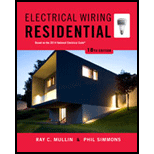
Electrical Wiring Residential
18th Edition
ISBN: 9781285170954
Author: Ray C. Mullin, Phil Simmons
Publisher: Cengage Learning
expand_more
expand_more
format_list_bulleted
Concept explainers
Textbook Question
Chapter 28, Problem 17R
Repeat problem 16 for a main service panel that consists of 100-ampere main current- limiting fuses and breakers for the branch circuits. The branch circuit trips; the 100-ampere fuses do not open. This condition is referred to as being (selective) (non-selective). (Circle the correct answer.)
Expert Solution & Answer
Trending nowThis is a popular solution!

Students have asked these similar questions
Find Va and Vb using Mesh analysis
Find Va and Vb using Nodal analysis
Please solve this question step by step and handwritten and do not use chat gpt or ai tools thank you very much!
Chapter 28 Solutions
Electrical Wiring Residential
Ch. 28 - What is the minimum size service for a one-family...Ch. 28 - Prob. 2RCh. 28 - Prob. 3RCh. 28 - Prob. 4RCh. 28 - Prob. 5RCh. 28 - Prob. 6RCh. 28 - Prob. 7RCh. 28 - List the standard sizes of fuses and circuit...Ch. 28 - Prob. 9RCh. 28 - Using the method shown in this unit, what is the...
Ch. 28 - State four possible combinations of service...Ch. 28 - Which Code section states that all overcurrent...Ch. 28 - All electrical components have some sort of...Ch. 28 - Arc-fault damage is closely related to the value...Ch. 28 - The utility company has provided a letter to the...Ch. 28 - While working on the main panelboard that is...Ch. 28 - Repeat problem 16 for a main service panel that...Ch. 28 - NEC ______________________________ generally...Ch. 28 - Prob. 19RCh. 28 - Prob. 20RCh. 28 - Overcurrent devices must be accessible. (True)...
Knowledge Booster
Learn more about
Need a deep-dive on the concept behind this application? Look no further. Learn more about this topic, electrical-engineering and related others by exploring similar questions and additional content below.Similar questions
- What are the four conditions that must be met before a generator is connected to a 3 phase system?arrow_forwardPlease solve this question step by step and handwritten and do not use chat gpt or ai tools thank you very much!arrow_forwardPlease solve question c and d step by step and handwritten and do not use chat gpt or ai tools thank you very much!arrow_forward
- Please solve questions d,e,f step by step and handwritten and do not use chat gpt or ai tools thank you very much!arrow_forwardPlease solve this question step by step and handwritten and do not use chat gpt or ai tools thank you very much!arrow_forwardPlease solve question c,d,e step by step and handwritten and do not use chat gpt or ai tools thank you very much!arrow_forward
- Q1: Design a logic circuit for the finite-state machine described by the assigned table in Fig. 1: Using D flip-flops. a. b. Using T flip-flops. Present Next State Output State x=0 x=0 YE Y₁Y Y₁Y Z 00 00 01 0 0 от 00 0 0 10 00 10 11 00 10 0arrow_forwardFind Va and Vb using mesh analysisarrow_forwardFind Va and Vb using Mesh analysisarrow_forward
- Find Va and Vb using nodal analysisarrow_forward2. Using the approximate method, hand sketch the Bode plot for the following transfer functions. a) H(s) = 10 b) H(s) (s+1) c) H(s): = 1 = +1 100 1000 (s+1) 10(s+1) d) H(s) = (s+100) (180+1)arrow_forwardQ4: Write VHDL code to implement the finite-state machine described by the state Diagram in Fig. 1. Fig. 1arrow_forward
arrow_back_ios
SEE MORE QUESTIONS
arrow_forward_ios
Recommended textbooks for you
 EBK ELECTRICAL WIRING RESIDENTIALElectrical EngineeringISBN:9781337516549Author:SimmonsPublisher:CENGAGE LEARNING - CONSIGNMENT
EBK ELECTRICAL WIRING RESIDENTIALElectrical EngineeringISBN:9781337516549Author:SimmonsPublisher:CENGAGE LEARNING - CONSIGNMENT Electricity for Refrigeration, Heating, and Air C...Mechanical EngineeringISBN:9781337399128Author:Russell E. SmithPublisher:Cengage Learning
Electricity for Refrigeration, Heating, and Air C...Mechanical EngineeringISBN:9781337399128Author:Russell E. SmithPublisher:Cengage Learning

EBK ELECTRICAL WIRING RESIDENTIAL
Electrical Engineering
ISBN:9781337516549
Author:Simmons
Publisher:CENGAGE LEARNING - CONSIGNMENT

Electricity for Refrigeration, Heating, and Air C...
Mechanical Engineering
ISBN:9781337399128
Author:Russell E. Smith
Publisher:Cengage Learning
FMPR-103 pt1 l Power Systems Protection v1; Author: L&D for Protection and Control;https://www.youtube.com/watch?v=ELWncjsh5uE;License: Standard Youtube License